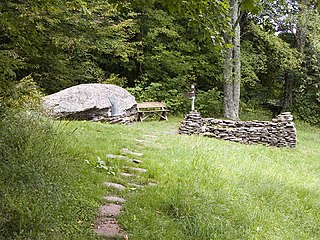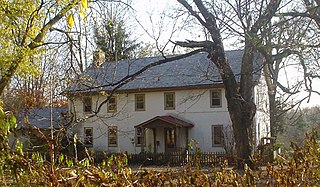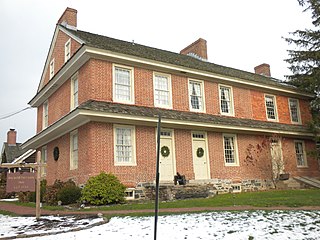
Washington Crossing State Park is a 3,575-acre (14 km2) New Jersey state park that is part of Washington's Crossing, a U.S. National Historic Landmark area. It is located in the Washington Crossing and Titusville sections of Hopewell Township in Mercer County, north of Trenton along the Delaware River. The park is operated and maintained by the New Jersey Division of Parks and Forestry. It is supported by the Washington Crossing Park Association, a friends group that works to preserve, enhance, and advocate for the park.

Washington Crossing Historic Park is a 500-acre (2 km²) state park operated by the Pennsylvania Department of Conservation and Natural Resources in partnership with the Friends of Washington Crossing Park. The park is divided into two sections. One section of the park, the "lower park," is headquartered in the village of Washington Crossing located in Upper Makefield Township in Bucks County, Pennsylvania. It marks the location of George Washington's crossing of the Delaware River during the American Revolutionary War.

The Delaware and Hudson Canal was the first venture of the Delaware and Hudson Canal Company, which would later build the Delaware and Hudson Railway. Between 1828 and 1899, the canal's barges carried anthracite coal from the mines of Northeastern Pennsylvania to the Hudson River and thence to market in New York City.

Woodchuck Lodge is a historic house on Burroughs Memorial Road in a remote part of the western Catskills in Roxbury, New York. Built in the mid-19th century, it was the last home of naturalist and writer John Burroughs (1837-1921) from 1908, and is the place of his burial. The property is now managed by the state of New York as the John Burroughs Memorial State Historic Site, and the house is open for tours on weekends between May and October. The property is a National Historic Landmark, designated in 1962 for its association with Burroughs, one of the most important nature writers of the late 19th and early 20th centuries.

John Evans House, also known as Raub Hall at the University of Delaware, is a historic home located at Newark in New Castle County, Delaware. The first section was built about 1800. The house in its present form is a two-story, gable roofed brick structure measuring six bays across. The original structure was expanded during the 19th and early 20th centuries to its present size. After 1888, it was converted to commercial use. In 1947, it was purchased by the University of Delaware and renovated in the 1960s for office space.

The Gilpin Homestead, also known as General Howe Headquarters, is a historic home located in Chadds Ford, Delaware County, Pennsylvania. The original house was built in 1754, and consisted of a brick building with two basement rooms, two first-floor rooms, two bedrooms, and the attic. About 1811, a stone addition was built that is now the middle of the house, and a second stone addition was completed by 1859. A porch was added between 1870 and 1897, and the garage was attached in 1949. Also on the property are a carriage house-barn, small barn, spring house, a creamery-cheese house, and the stone remains of a barn built in 1860. William Howe, 5th Viscount Howe used the Gilpin house as his headquarters from late afternoon of September 11, until the morning of September 16, 1777, after the Battle of Brandywine. The 1754 section was added to an earlier house, probably built in the 1730s. This was eventually torn down to allow for the 19th century additions. There is not, and never was a staircase in the 1754 section, but visible on the plaster wall in the present stair hall, is the "witness" of the original stair. It was added to the National Register of Historic Places in 1971.

Dilworthtown Historic District is a national historic district located in Dilworthtown, Birmingham Township, Chester County, Pennsylvania. It encompasses eight contributing buildings in the crossroads community of Dilworthtown. They include the Dilworth House, stone house (1820), Dilworthtown Lyceum or meeting hall, Dilworthtown Store (1858), two tenant houses, and a two-story log cabin dated to 1686 or the early-18th century. The focal point of the district is the Dilworth House, also known as the Dilworthtown Inn, which has operated as an inn and tavern since the late 18th century. The town was at the center of the fighting during the Battle of Brandywine in September 1777.

Peter Marsh House, also known as The Homestead, is a historic home located at Rehoboth Beach, Sussex County, Delaware. The original house was built in the mid-18th century and consists of the 2+1⁄2-story, two-bay, main section and 1+1⁄2-story, three-bay kitchen wing. Attached to the kitchen wing is a one-story, one bay addition also dated to the mid 18th century, likely 1743. A two-story, two-bay addition with garage was added in the 20th century. The house is clad in cypress shingles. It was restored in the 1930s by Colonel Wilbur Corkran. It is owned by the University of Delaware.

Brecknock, also known as the Howell's Mill Seat, is a historic home located near Camden, Kent County, Delaware. The house is in four sections; two of brick and two frame. The original one-room house possibly dates before 1700 and is constructed of brick. A brick section was added in the 1740s. The 2+1⁄2-story, frame, main house was added in the mid-18th century and abuts the second brick section. The final frame section was added in the 1880s and is a four-room apartment originally built for the wagon driver, but later incorporated into the house.

Green Mansion House is a historic home located at Kenton, Kent County, Delaware. The house dates to the first quarter of the 19th century, and consists of two sections. The frame section is a two-story, three bay, center hall plan structure. Attached to it is a two-story, two bay stuccoed brick wing. The house was built as part of Philip Lewis' plan for the development of Kenton.

James Stewart Jr. House is a historic home located at Christiana, New Castle County, Delaware. It was built in the late-18th century, and is a two-story, five bay, brick dwelling. It consists of a three bay, double pile section and a two bay single pile section. The front facade features a three bay, one story, hip-roofed facade porch with turned posts and added in the 20th century.

James Stewart House, also known as Holly Farm, is a historic home and farm located near Glasgow, New Castle County, Delaware, United States. The oldest section dates to the second half of the 18th century, with additions dating to the 18th and 19th centuries. It consists of three distinct two-story, gable-roofed, brick sections joined at the endwalls, plus a one-story, brick lean-to. The oldest section is the first floor of the central section. Also on the property are contributing outbuildings including a brick smokehouse, shop, a corn crib/granary, two sheds, a privy, a bank barn, a milkhouse, and a machine shed.

Old Cann Mansion House is a historic home located at Kirkwood, New Castle County, Delaware. It was built about 1792, and consists of three sections. The main section is a 2+1⁄2-story, five-bay double-pile brick structure. Attached to it is a lower 2+1⁄2-story, single-pile wing. In the rear is a two-story, frame addition built in the late 19th century. The house is in the Georgian style. Also on the property are a contributing frame board-and-batten barn and privy, and three frame sheds.

Galloway-Walker House is a historic home located at Newport, New Castle County, Delaware. The original section was built 18th century, and is a 1+1⁄2-story, three bay, brick dwelling with a gambrel roof. The house was expanded with a frame addition to add a fourth bay in the late-19th century. It is a hall-parlor plan dwelling.

Bartley–Tweed Farm is a historic farm located near Newark, New Castle County, Delaware. The property includes three contributing buildings: a stuccoed stone and brick house, a frame bank barn built about 1835, and a late 19th-century frame carriage house / granary. The stone section of the house dates to the late-18th century and the brick section to about 1825. The brick section has Federal style details.

Greenbank Historic Area is a historic grist mill located at Marshallton, New Castle County, Delaware. The property includes the Greenbank Mill, Robert Philips House, and the W. G. Philips House. The mill was built in 1790 and expanded in 1812. It is a 2+1⁄2 story, frame structure with a stone wing. The mill measures 50 feet (15 m) by 39 feet (12 m). The Robert Philips House was built in 1783, and is a 2+1⁄2 story, five bay, stone dwelling with a gable roof. The front facade features a long verandah. The W. G. Philips House, also known as the mill owner's house, dates to the mid-19th century. It consists of a two-story, three bay front section with a three-story, hipped roof rear section. Oliver Evans, a native of nearby Newport, installed his automatic mill machinery in the 1790 building.

Comdr. Thomas MacDonough House, also known as The Trap, is a historic home located near Odessa, New Castle County, Delaware. It was built in several sections. The two main sections are two stories and consists of a three bay brick section dated to the mid-18th century and a three bay frame section built between 1820 and 1830. Later-19th century additions to the house include frame one-and 1+1⁄2-story wings to the south gable end wall and southwest rear wall. Also on the property is a contributing farm building complex, including a shed, root cellar, and privy. It was the home of Commander Thomas MacDonough (1783-1825), an early-19th-century American naval officer noted for his roles in the First Barbary War and the War of 1812.

Vandyke-Heath House, also known as the Jacob C. Vandyke House, is a historic home located near Townsend, New Castle County, Delaware. The house was built in three stages. The earliest section dates to the late-18th century, and was a 1+1⁄2-story, three bay log structure measuring 16 feet by 21 feet. It was raised to a full two stories in the mid-19th century and a 2+1⁄2-story, two-bay frame wing was added. A two-story, two bay addition was built in the late-19th century. It is in the Federal style.

Delaware Avenue Historic District is a national historic district located at Wilmington, New Castle County, Delaware. It encompasses 180 contributing buildings and 1 contributing structure developed in the late-19th and early-20th centuries. The district is primarily residential and includes a variety of Victorian-era mansions and large dwellings in a variety of popular architectural styles including Italianate, Queen Anne, Colonial Revival, Classical Revival, and American Four Square The houses are detached or semi-detached and are primarily three stories in height with extensive wings to the rear. The district also includes 20th century apartment complexes. Also located in the district is the St. Stephen's Lutheran Church and the Sailors and Soldiers Monument. The separately listed Howard Pyle Studios are also located in the district.

Pursley's Ferry Historic District is a 61-acre (25 ha) historic district located along Old River Road near Church Road by the Delaware River in Holland Township, Hunterdon County, New Jersey. It was added to the National Register of Historic Places on October 8, 1980 for its significance in architecture, commerce, and transportation. The district includes 4 contributing buildings.
























